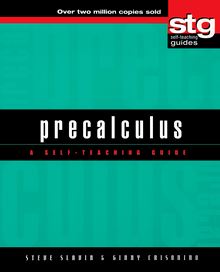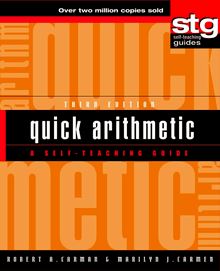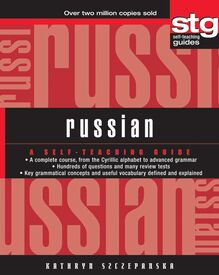Precalculus , livre ebook
188
pages
English
Ebooks
2001
Vous pourrez modifier la taille du texte de cet ouvrage
Obtenez un accès à la bibliothèque pour le consulter en ligne En savoir plus
Découvre YouScribe en t'inscrivant gratuitement
Découvre YouScribe en t'inscrivant gratuitement
188
pages
English
Ebooks
2001
Vous pourrez modifier la taille du texte de cet ouvrage
Obtenez un accès à la bibliothèque pour le consulter en ligne En savoir plus
Publié par
Date de parution
12 janvier 2001
Nombre de lectures
1
EAN13
9780471437246
Langue
English
Poids de l'ouvrage
3 Mo
Do logarithmic functions throw you for a loop? Does the challenge of finding an inverse function leave you overwhelmed? Does the Law of Cosines make you feel clueless? With this helpful, easy-to-follow guide, you will gain total command of these precalc concepts-and many more-in no time at all.
Precalculus: A Self-Teaching Guide includes an algebra review and complete coverage of exponential functions, log functions, and trigonometry. Whether you are studying precalculus for the first time, want to refresh your memory, or need a little help for a course, this clear, interactive primer will provide you with the skills you need. Precalculus offers a proven self-teaching approach that lets you work at your own pace—and the frequent self-tests and exercises reinforce what you've learned. Turn to this one-of-a-kind teaching tool and, before you know it, you'll be solving problems like a mathematician!
Publié par
Date de parution
12 janvier 2001
Nombre de lectures
1
EAN13
9780471437246
Langue
English
Poids de l'ouvrage
3 Mo
Precalculus
A Self-Teaching Guide
Precalculus
A Self-Teaching Guide
Steve Slavin, Ginny Crisonino
John Wiley Sons, Inc.
New York Chichester Weinheim Brisbane Singapore Toronto
This book is printed on acid-free paper.
Copyright 2001 by Steve Slavin and Ginny Crisonino. All rights reserved
Published by John Wiley Sons, Inc.
Published simultaneously in Canada
No part of this publication may be reproduced, stored in a retrieval system, or transmitted in any form or by any means, electronic, mechanical, photocopying, recording, scanning, or otherwise, except as permitted under Section 107 or 108 of the 1976 United States Copyright Act, without either the prior written permission of the Publisher, or authorization through payment of the appropriate per-copy fee to the Copyright Clearance Center, 222 Rosewood Drive, Danvers, MA 01923, (978) 750-8400, fax (978) 750-4744. Requests to the Publisher for permission should be addressed to the Permissions Department, John Wiley Sons, Inc., 605 Third Avenue, New York, NY 10158-0012, (212) 850-6011, fax (212) 850-6008, email: PERMREQ@WILEY.COM .
This publication is designed to provide accurate and authoritative information in regard to the subject matter covered. It is sold with the understanding that the publisher is not engaged in rendering professional services. If professional advice or other expert assistance is required, the services of a competent professional person should be sought.
ISBN 0-471-37823-2
10 9 8 7 6 5 4
Contents
1 The Basics
Pretest
1 Exponents
2 Polynomials
3 Rational Exponents and Radicals
4 Factoring
5 Basic Geometry
6 Applications
2 Functions
1 Definition of a Function
2 Operations on Functions
3 Composite Functions
4 Inverse Functions
3 Graphs of Functions
1 Intercepts
2 Slope of a Straight Line
3 Writing the Equation of a Straight Line
4 Graphs of Linear Functions
5 Graphs of Quadratic Functions
6 Graphs of Polynomial Functions of Degree 3 and Higher
7 Asymptotes
8 Oblique Asymptotes and Graphs of Rational Functions
4 Exponential and Logarithmic Functions
1 Exponential Functions
2 Logarithmic Functions
3 Properties of Logarithmic Functions
4 Solving Logarithmic Equations
5 Applications
5 Trigonometry
1 Angles and Their Measure
2 Right-Triangle Trigonometry
3 Trigonometric Functions of Any Angle
4 Graphs of the Basic Trigonometric Functions
5 Inverse Trigonometric Functions
6 Applications
6 Analytic Trigonometry
1 Using Fundamental Identities
2 Verifying Trigonometric Identities
3 Solving Trigonometric Equations
4 Sum and Difference Formulas
5 Multiple-Angle and Product-to-Sum Formulas
7 Additional Topics in Trigonometry
1 Law of Sines
2 Law of Cosines
3 Area of a Triangle
8 Miscellaneous Topics
1 Solving Systems of Inequalities and Linear Programming
2 Partial Fraction Decomposition
Index
Precalculus
A Self-Teaching Guide
1 The Basics
Before proceeding to precalculus, we ll review some basic concepts. This chapter provides a bridge from elementary algebra to intermediate algebra and other topics in precalculus. Most of these concepts should be somewhat familiar, and you should be able to quickly pick up where you left off in algebra, whether it was last week, last year, or even the last millennium.
When you ve completed this chapter you should be able to work with:
exponents
polynomials
rational exponents and radicals
factoring
basic geometry
applications
Before we begin, try the following pretest to get an idea of how much review you need, if any. If you get a perfect score on the pretest, you can skip chapter 1 and go directly to chapter 2. To learn precalculus you have to have your intermediate algebra down cold.
PRETEST
Simplify the following expressions. Do not leave negative exponents in your final answer. Leave all answers in fully reduced form.
Part 1: Exponents
Simplify the following:
1.
2.
3.
4.
5.
6.
7.
8.
9.
10.
Part 2: Polynomials
11.
12.
13.
14.
15.
16.
17.
18.
19.
Part 3: Factoring
Factor the following:
20.
21.
22.
23.
24.
25.
26.
27.
28.
29.
Part 4: Rational Exponents and Radicals
Simplify the following:
30.
31.
32.
33.
34.
35.
36.
37.
38.
Part 5: Basic Geometry
39. Find the length of the unknown side in the triangle below.
40. Find the circumference and the area of a circle with diameter 10 inches.
41. Find the volume of the rectangular solid with length 10, height 2, and width 4.
42. Find the distance of the line segment below and its midpoint.
Part 6: Applications
43. A specialty coffee shop wishes to blend a $6-per-pound coffee with an $11-per-pound coffee to produce a blend that will sell for $8 per pound. How much of each should be used to produce 300 pounds for the new blend?
44. An investor has $20,000 to invest. If part grows at an interest rate of 8 percent and the rest at 12 percent, how much should be invested at each rate to yield 11 percent on the total amount invested?
45. A boat takes 1.5 times as long to go 360 miles up a river than to return. If the boat cruises at 15 miles per hour in still water, what is the rate of the current?
ANSWERS:
1.
2.
3.
4. 1
5.
6.
7.
8.
9.
10.
11.
12.
13.
14.
15.
16.
17.
18.
19.
20.
21.
22.
23.
24.
25.
26.
27.
28.
29.
30.
31.
32.
33.
34.
35.
36.
37.
38.
39.
40.
41.
42.
43.
44.
45.
1 Exponents
As you should already be aware, exponents are a way of showing repeated multiplication. For example, 2 3 (read two cubed or two to the third power ) means we multiply 2(2)(2) = 8. The 2 is the base and the 3 is the exponent, or power. The exponent tells us how many times we use the base as a factor. So, a 3 = a ( a )( a ). The reverse is also true: we could say that x ( x )( x )( x )( x ) = x 5 (read x to the fifth power ). There are nine basic laws of exponents you should know for precalculus. As we go over these laws, we ll ask you to try some, then check your answers with ours. There will be problems where you will have to apply more than one of these laws. Generally you don t have to apply them in the same order we have. There is no preset order of laws used for simplifying exponents. Let s get started.
Law 1:
When multiplying, if the bases are the same, add the exponents.
Example 1:
Example 2:
Don t forget y is 1 y 1 .
Example 3:
Example 4:
Multiply the coefficients, add the exponents.
Law 2:
When raising a power to a power, multiply the exponents.
Example 5:
Example 6:
Example 7:
Law 3:
The c is a constant. If a constant is in parentheses with an exponent on the outside of the parentheses, the constant is also raised to that power.
Example 8:
Example 9:
Law 4:
When raising a fraction to a power, multiply the exponents in both the numerator and the denominator by the power.
Example 10:
Example 11:
Before we go over the remaining laws of exponents, try the following problems:
SELF-TEST 1:
1.
2.
3.
4.
5.
ANSWERS:
1.
2.
3.
4.
5.
Law 5:
Example 12:
Example 13:
Example 14:
Law 6:
Anything (except 0) to the zero power is 1.
Example 15:
Example 16:
Example 17:
Law 7:
Anything (except 0) to a negative power becomes a fraction, with 1 over itself to the positive power.
Example 18:
Example 19:
Notice that only t 5 moved down to the denominator, not the 2. Because the 2 isn t in parentheses, it isn t raised to the negative fifth power. See the next example for a slightly different case.
Example 20:
Since both the 2 and the t are inside the parentheses, they are both raised to the negative fifth power, so they both move to the denominator.
Law 8:
When a base in the denominator is raised to a negative power, the base moves up to the numerator and the exponent changes to a positive.
Example 21:
The x 4 in the denominator moved up to the numerator as x 4 .
Example 22:
The s 3 moved down to the denominator as an s 3 , and the t 2 moved up to the numerator as t 2 .
Law 9:
A fraction to a negative power becomes its reciprocal to the positive power. Exponents inside the parentheses do not change sign when you flip the fraction.
Example 23:
Example 24
Notice only the fraction on the outside of the parentheses changes sign when law 9 is applied.
SELF-TEST 2:
1.
2.
3.
4.
5.
6.
7.
8.
9.
10.
ANSWERS:
1.
2. 1
3. 1
4.
5.
6.
7.
Notice that if we move the negative exponents from the numerator to the denominator, or from the denominator to the numerator, the exponents become positive.
8.
9.
10.
2 Polynomials
A polynomial is an algebraic expression involving addition, subtraction, or multiplication of terms whose exponents are non-negative integers. That means no negative or fractional exponents. That also means no variables in any denominator. Some examples of polynomials are:
Some examples of algebraic expressions that are not polynomials are:
This is not a polynomial because there s a variable in the denominator.
This is not a polynomial because there s a negative exponent.
This is not a polynomial because there s a fractional exponent.
When we have studied polynomials more we ll find that they are very useful when we want to write an algebraic statement to represent a real-life situation. We ll see some examples of this in chapter 2, when we study functions.
Now that we know what a polynomial is, it s time for us to add and subtract polynomials. When we add or subtract the terms of polynomials, it s called combining like terms. Remember, combining like terms applies only to addition and subtraction. Let s look first at what like terms are.
Like terms are the same variables to the same powers. Notice that our definition doesn t require like terms to have


